Abstract
Peptide p-nitroanilide substrates and peptidylchloromethane inhibitors were used to examine the specificity of activated human Protein C. Substrates with arginine in the P1 position had the highest activity. The best substrates and inhibitors, as judged by the second-order rate constant for their interaction with the enzyme, had an apolar residue in the P2 position. In contrast with thrombin [Kettner & Shaw (1981) Methods Enzymol. 80, 826-842], activated Protein C was able to accommodate large hydrophobic residues such as phenylalanine and leucine in the P2 position. In the P3 position, the enzyme preferred an apolar D-amino acid residue. The results of the present study have also indicated a suitable substrate and inhibitor to be used in the assay of functional protein C and of thrombomodulin.
Full text
PDF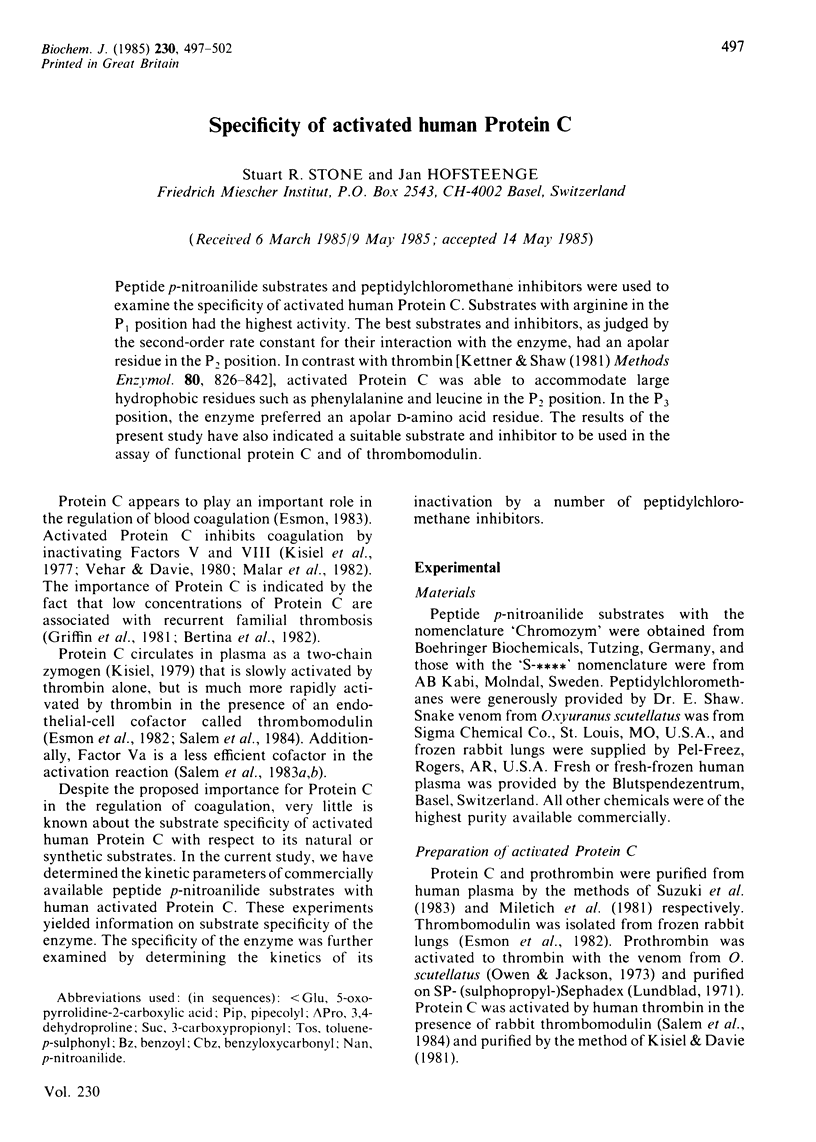
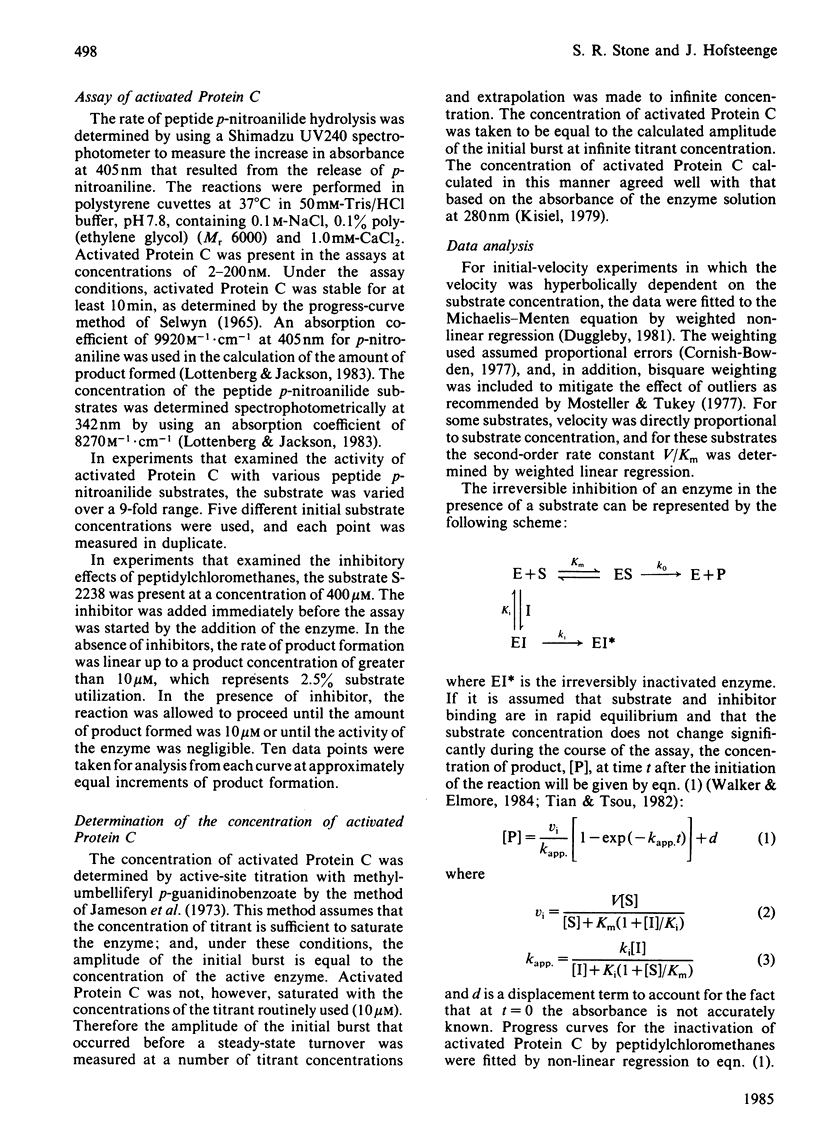
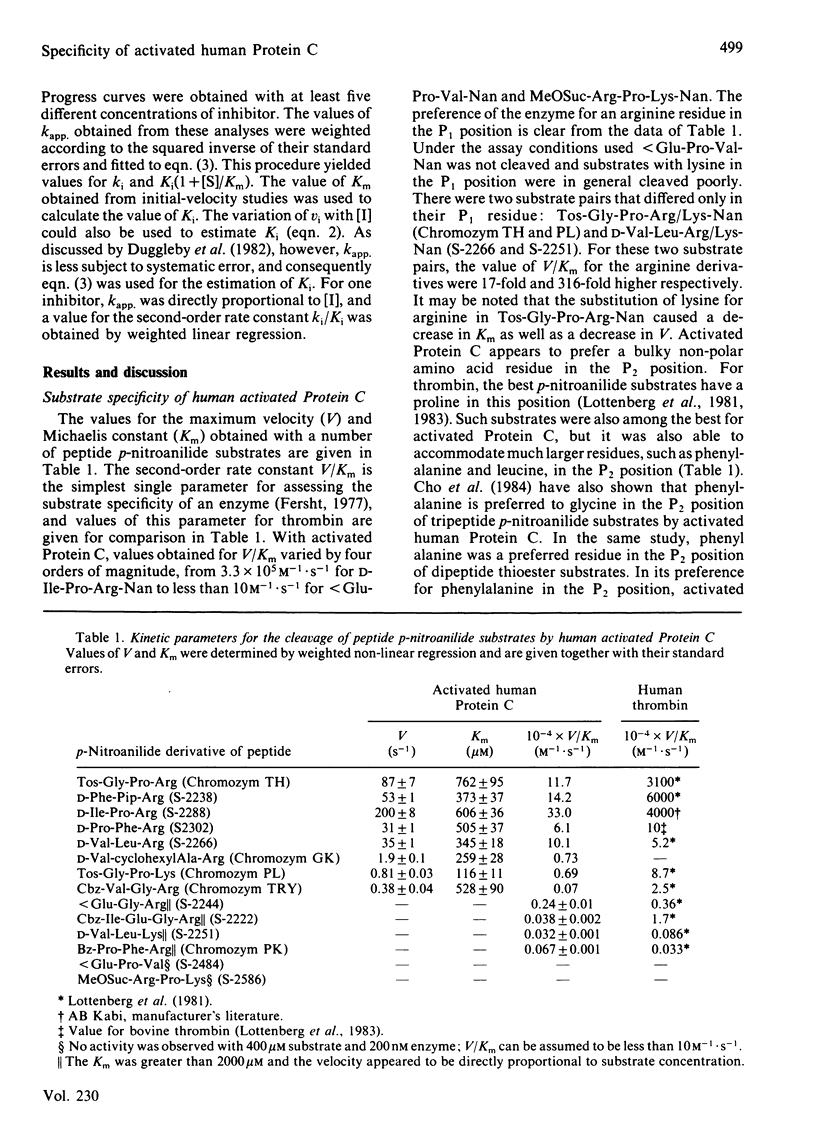
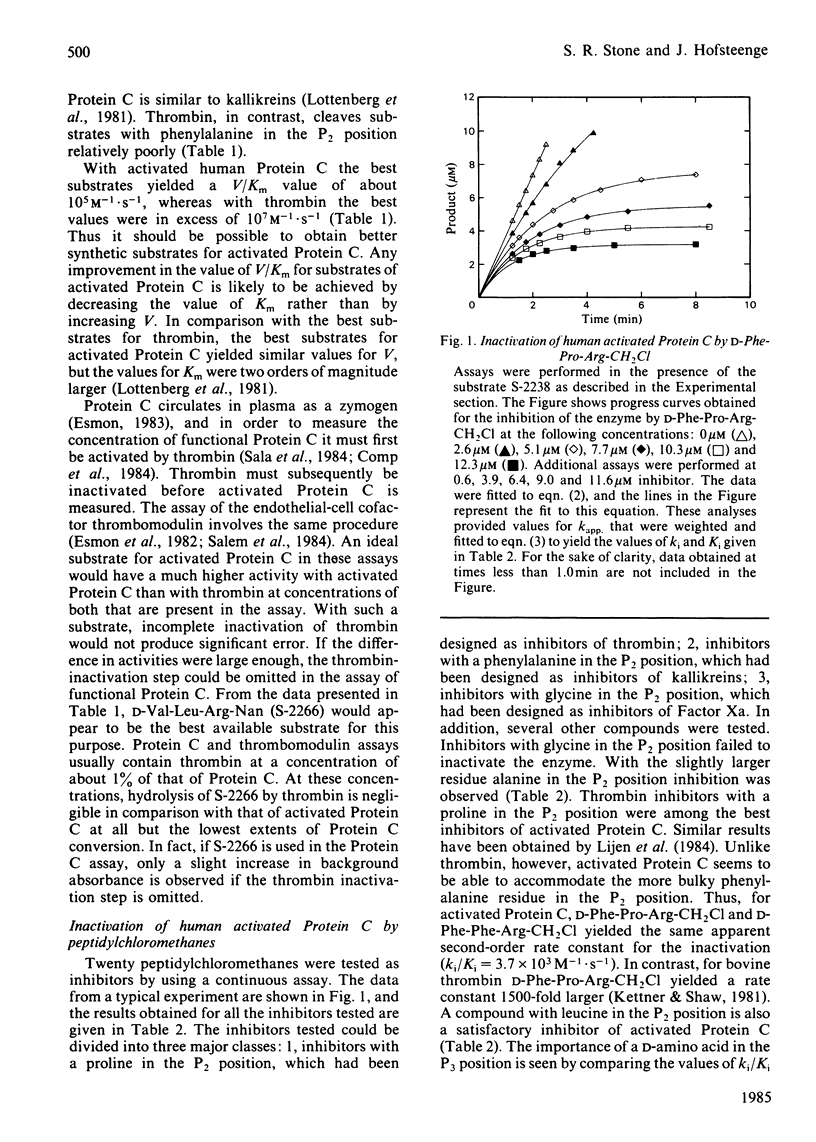
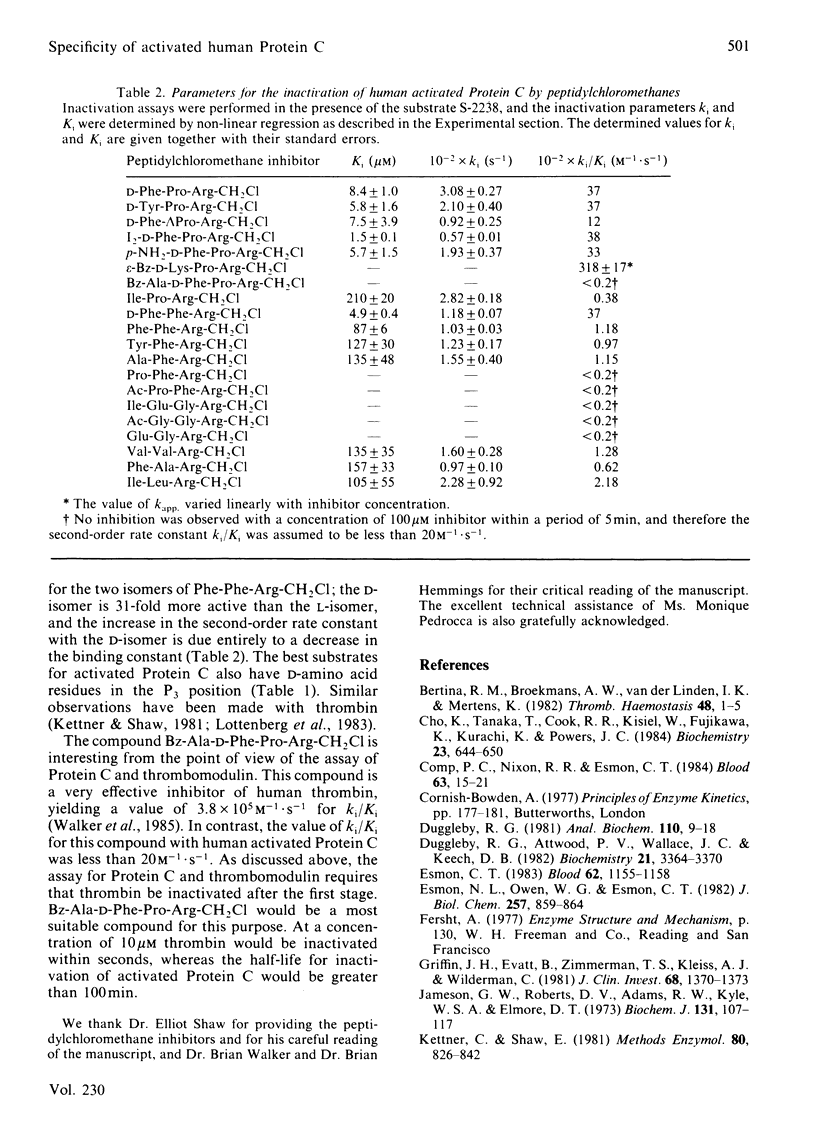
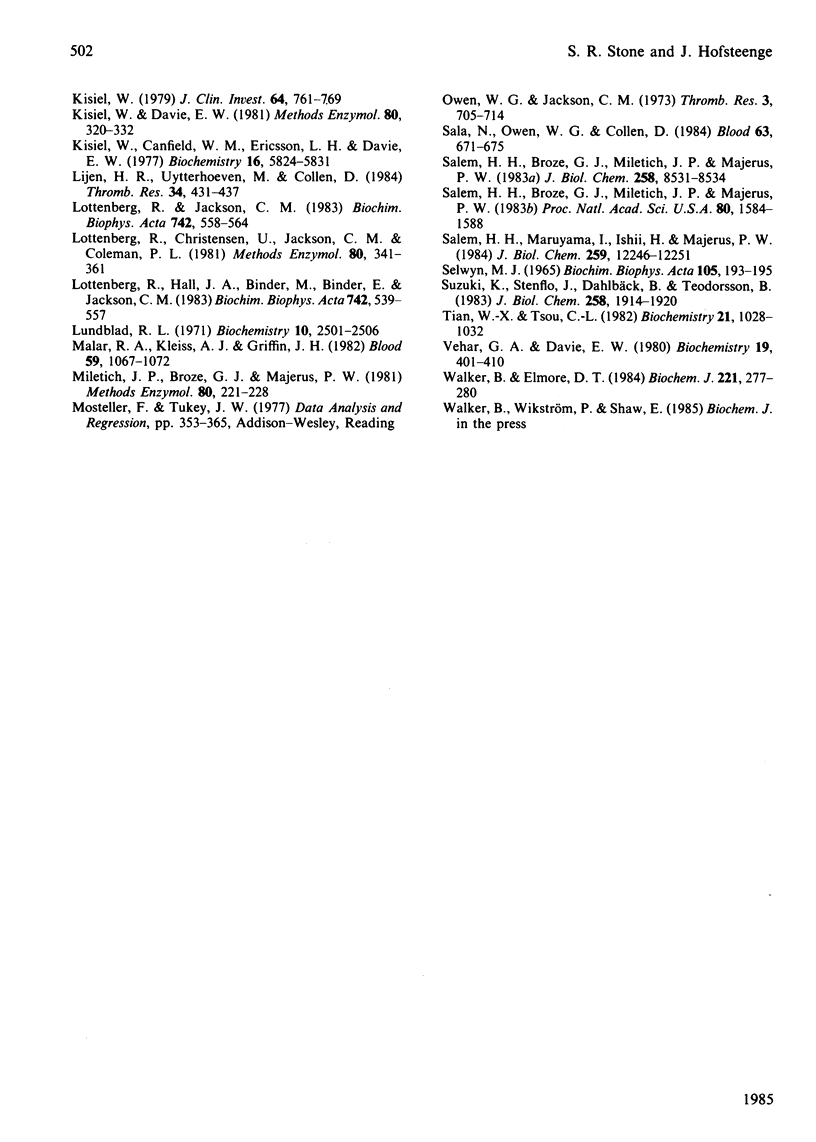
Selected References
These references are in PubMed. This may not be the complete list of references from this article.
- Bertina R. M., Broekmans A. W., van der Linden I. K., Mertens K. Protein C deficiency in a Dutch family with thrombotic disease. Thromb Haemost. 1982 Aug 24;48(1):1–5. [PubMed] [Google Scholar]
- Cho K., Tanaka T., Cook R. R., Kisiel W., Fujikawa K., Kurachi K., Powers J. C. Active-site mapping of bovine and human blood coagulation serine proteases using synthetic peptide 4-nitroanilide and thio ester substrates. Biochemistry. 1984 Feb 14;23(4):644–650. doi: 10.1021/bi00299a009. [DOI] [PubMed] [Google Scholar]
- Comp P. C., Nixon R. R., Esmon C. T. Determination of functional levels of protein C, an antithrombotic protein, using thrombin-thrombomodulin complex. Blood. 1984 Jan;63(1):15–21. [PubMed] [Google Scholar]
- Duggleby R. G. A nonlinear regression program for small computers. Anal Biochem. 1981 Jan 1;110(1):9–18. doi: 10.1016/0003-2697(81)90104-4. [DOI] [PubMed] [Google Scholar]
- Duggleby R. G., Attwood P. V., Wallace J. C., Keech D. B. Avidin is a slow-binding inhibitor of pyruvate carboxylase. Biochemistry. 1982 Jul 6;21(14):3364–3370. doi: 10.1021/bi00257a018. [DOI] [PubMed] [Google Scholar]
- Esmon C. T. Protein-C: biochemistry, physiology, and clinical implications. Blood. 1983 Dec;62(6):1155–1158. [PubMed] [Google Scholar]
- Esmon N. L., Owen W. G., Esmon C. T. Isolation of a membrane-bound cofactor for thrombin-catalyzed activation of protein C. J Biol Chem. 1982 Jan 25;257(2):859–864. [PubMed] [Google Scholar]
- Griffin J. H., Evatt B., Zimmerman T. S., Kleiss A. J., Wideman C. Deficiency of protein C in congenital thrombotic disease. J Clin Invest. 1981 Nov;68(5):1370–1373. doi: 10.1172/JCI110385. [DOI] [PMC free article] [PubMed] [Google Scholar]
- Jameson G. W., Roberts D. V., Adams R. W., Kyle W. S., Elmore D. T. Determination of the operational molarity of solutions of bovine alpha-chymotrypsin, trypsin, thrombin and factor Xa by spectrofluorimetric titration. Biochem J. 1973 Jan;131(1):107–117. doi: 10.1042/bj1310107. [DOI] [PMC free article] [PubMed] [Google Scholar]
- Kettner C., Shaw E. Inactivation of trypsin-like enzymes with peptides of arginine chloromethyl ketone. Methods Enzymol. 1981;80(Pt 100):826–842. doi: 10.1016/s0076-6879(81)80065-1. [DOI] [PubMed] [Google Scholar]
- Kisiel W., Canfield W. M., Ericsson L. H., Davie E. W. Anticoagulant properties of bovine plasma protein C following activation by thrombin. Biochemistry. 1977 Dec 27;16(26):5824–5831. doi: 10.1021/bi00645a029. [DOI] [PubMed] [Google Scholar]
- Kisiel W. Human plasma protein C: isolation, characterization, and mechanism of activation by alpha-thrombin. J Clin Invest. 1979 Sep;64(3):761–769. doi: 10.1172/JCI109521. [DOI] [PMC free article] [PubMed] [Google Scholar]
- Lijnen H. R., Uytterhoeven M., Collen D. Inhibition of trypsin-like serine proteinases by tripeptide arginyl and lysyl chloromethylketones. Thromb Res. 1984 Jun 1;34(5):431–437. doi: 10.1016/0049-3848(84)90247-0. [DOI] [PubMed] [Google Scholar]
- Lottenberg R., Christensen U., Jackson C. M., Coleman P. L. Assay of coagulation proteases using peptide chromogenic and fluorogenic substrates. Methods Enzymol. 1981;80(Pt 100):341–361. doi: 10.1016/s0076-6879(81)80030-4. [DOI] [PubMed] [Google Scholar]
- Lottenberg R., Hall J. A., Blinder M., Binder E. P., Jackson C. M. The action of thrombin on peptide p-nitroanilide substrates. Substrate selectivity and examination of hydrolysis under different reaction conditions. Biochim Biophys Acta. 1983 Feb 15;742(3):539–557. doi: 10.1016/0167-4838(83)90272-8. [DOI] [PubMed] [Google Scholar]
- Lottenberg R., Jackson C. M. Solution composition dependent variation in extinction coefficients for p-nitroaniline. Biochim Biophys Acta. 1983 Feb 15;742(3):558–564. doi: 10.1016/0167-4838(83)90273-x. [DOI] [PubMed] [Google Scholar]
- Lundblad R. L. A rapid method for the purification of bovine thrombin and the inhibition of the purified enzyme wtih phenylmethylsulfonyl fluoride. Biochemistry. 1971 Jun 22;10(13):2501–2506. doi: 10.1021/bi00789a012. [DOI] [PubMed] [Google Scholar]
- Marlar R. A., Kleiss A. J., Griffin J. H. Mechanism of action of human activated protein C, a thrombin-dependent anticoagulant enzyme. Blood. 1982 May;59(5):1067–1072. [PubMed] [Google Scholar]
- Sala N., Owen W. G., Collen D. A functional assay of protein C in human plasma. Blood. 1984 Mar;63(3):671–675. [PubMed] [Google Scholar]
- Salem H. H., Broze G. J., Miletich J. P., Majerus P. W. Human coagulation factor Va is a cofactor for the activation of protein C. Proc Natl Acad Sci U S A. 1983 Mar;80(6):1584–1588. doi: 10.1073/pnas.80.6.1584. [DOI] [PMC free article] [PubMed] [Google Scholar]
- Salem H. H., Broze G. J., Miletich J. P., Majerus P. W. The light chain of factor Va contains the activity of factor Va that accelerates protein C activation by thrombin. J Biol Chem. 1983 Jul 25;258(14):8531–8534. [PubMed] [Google Scholar]
- Salem H. H., Maruyama I., Ishii H., Majerus P. W. Isolation and characterization of thrombomodulin from human placenta. J Biol Chem. 1984 Oct 10;259(19):12246–12251. [PubMed] [Google Scholar]
- Selwyn M. J. A simple test for inactivation of an enzyme during assay. Biochim Biophys Acta. 1965 Jul 29;105(1):193–195. doi: 10.1016/s0926-6593(65)80190-4. [DOI] [PubMed] [Google Scholar]
- Suzuki K., Stenflo J., Dahlbäck B., Teodorsson B. Inactivation of human coagulation factor V by activated protein C. J Biol Chem. 1983 Feb 10;258(3):1914–1920. [PubMed] [Google Scholar]
- Tian W. X., Tsou C. L. Determination of the rate constant of enzyme modification by measuring the substrate reaction in the presence of the modifier. Biochemistry. 1982 Mar 2;21(5):1028–1032. doi: 10.1021/bi00534a031. [DOI] [PubMed] [Google Scholar]
- Vehar G. A., Davie E. W. Preparation and properties of bovine factor VIII (antihemophilic factor). Biochemistry. 1980 Feb 5;19(3):401–410. doi: 10.1021/bi00544a001. [DOI] [PubMed] [Google Scholar]
- Walker B., Elmore D. T. The irreversible inhibition of urokinase, kidney-cell plasminogen activator, plasmin and beta-trypsin by 1-(N-6-amino-n-hexyl)carbamoylimidazole. Biochem J. 1984 Jul 1;221(1):277–280. doi: 10.1042/bj2210277. [DOI] [PMC free article] [PubMed] [Google Scholar]


